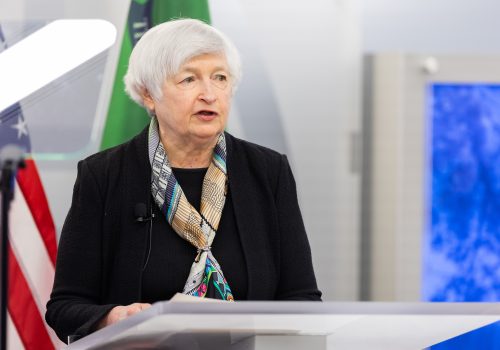The global infrastructure financing gap: Where sovereign wealth funds and pension funds can play a role
The global infrastructure financing gap is estimated to be around $15 trillion by 2040. To provide basic infrastructure for all people over the course of the next two decades, every year the world would need to spend just under $1 trillion more than the previous year in the infrastructure sector.
Most of this spending must happen in low-income economies. Nearly eight hundred million people in the world do not have access to electricity and basic drinking water services. Around 1.8 billion people in the world are not using basic sanitation services. The vast majority of these people reside in low-income economies, including the Sub-Saharan African and South Asian regions. Moreover, around 3.2 billion people around the world do not use the internet and only sixteen out of one hundred people have broadband subscriptions. As shown in figure 1, in low-income countries, only 21 percent of people have access to the internet, and only one in two hundred have broadband. Figure 1 can be explored for more detailed statistics on various forms of basic infrastructure gaps, such as in access to electricity, drinking water, sanitation, internet, and broadband.
From 2015 to 2020 assets under management (AUM) for sovereign wealth funds (SWFs) and private pension funds grew from $11 trillion to $15 trillion. As of the end of 2020, total global pension assets (public and private) exceeded $56 trillion, almost double the amount in 2010. Having more than $65 trillion in assets (see figure 2 and figure 3), institutional investors (such as SWFs and pension funds) are uniquely positioned to bridge low-income economies’ infrastructure financing gap in the coming decades. This is mainly because the investment horizons of institutional investors are often long-term with low but secure return expectations, which are characteristic of large-scale infrastructure projects. As shown in figure 2, Asia and the Middle East are home to some of the largest SWFs in the world, accounting for 40 percent and 34 percent of world’s total SWF assets, respectively. Available data suggests that cross-border investments of SWFs from these regions mainly target the financial and real estate sectors of advanced economies, accounting for around 40 percent of all their cross-border transactions.
As seen in figure 3, advanced economies are home to the world’s largest pension funds and retirement saving accounts. The United States accounts for around two-thirds of AUM in this industry. While highly liquid and low-risk assets such as bonds and equities have traditionally been the two main asset classes invested by pension funds and retirement saving accounts, they are slowly starting to invest in less liquid asset classes with longer return time-horizons, such as infrastructure and real estate. This could be a game-changer in filling the global infrastructure financing gap. However, despite their growing importance in the global economy and financial markets, institutional investors such as SWFs and pension funds account for less than 1 percent of private participation in infrastructure in developing economies, largely due to risks of long-terms investments in these countries.
It has long been clear that traditional mechanisms of public financing of infrastructure projects are not sufficient to meet the growing demand for infrastructure. This calls for new and innovative mechanisms to bring in investments from institutional investors and the private sector. To make this possible, infrastructure needs to be defined as an asset class that can readily be invested in by private and public entities alike. The establishment of Global Infrastructure Facility (GIF) by the World Bank is an effort in this regard. Such efforts have also been complemented by increasing activity in public-private partnerships. For example, in 2012, the World Pension Council and Organization for Economic Co-operation and Development first convened a meeting focusing on promoting pension funds’ exposure to long-term assets such as infrastructure investment.
The Bretton Woods Institutions (BWI) are uniquely positioned to encourage investment in developing countries’ infrastructure through providing various guarantee and insurance mechanisms, thereby reducing risk for private investors. In other words, BWI’s involvement in developing economies’ infrastructure projects can crowd-in institutional and private investors by reducing risks and increasing trust and transparency in such projects. While the establishment of the GIF by the World Bank is an important step forward, the following two reports identify other areas where the World Bank and International Monetary Fund could engage with private capital, non-state, and quasi-state actors (such as SWFs and pension funds) to bridge the infrastructure financing gap over the next few decades: Modernizing the Bretton Woods Institutions for the twenty-first century and Changing Bretton Woods Institutions: How non-state and quasi-state actors can help drive the global development agenda.
Amin Mohseni-Cheraghlou is a macroeconomist with the GeoEconomics Center and leads the Atlantic Council’s Bretton Woods 2.0 Project. He is also an assistant professor of economics at American University in Washington DC. @AMohseniC
Naomi Aladekoba is a consultant with the GeoEconomics Center focusing on Sub-Saharan Africa, Chinese foreign policy, and international development. @NAladekoba
Related reading

At the intersection of economics, finance, and foreign policy, the GeoEconomics Center is a translation hub with the goal of helping shape a better global economic future.


